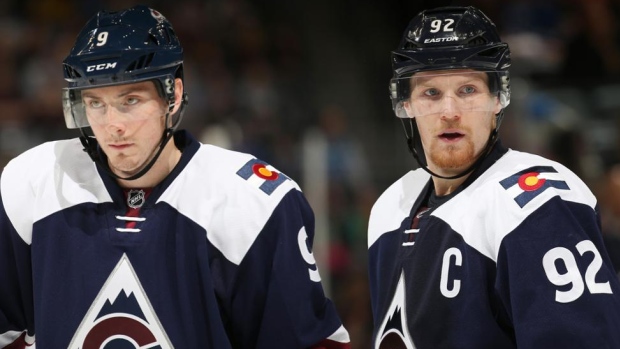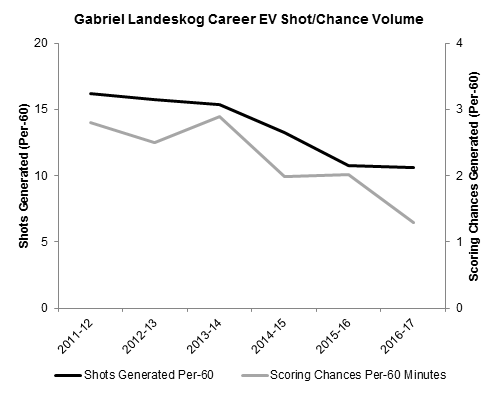Feb 27, 2017
Offensive trends curb Landeskog’s trade appeal
Colorado Avalanche winger Gabriel Landeskog is less of an individual offensive threat with each passing season,Travis Yost writes. The 24-year-old – along with teammate Matt Duchene – has reportedly been on the trade block for a couple of months now.
By Travis Yost

A player that’s certain to draw some attention as the trade deadline approaches is Colorado’s Gabriel Landeskog.
The 24-year-old winger – along with teammate Matt Duchene – has reportedly been on the trade block for a couple of months now. Whether or not Avalanche general manager Joe Sakic actually moves on from Landeskog is another question entirely, but the mere fact that his name has been out there and the trade talk hasn’t died down certainly suggests that the Avs are at least listening to potential offers.
Landeskog is an intriguing trade candidate for a couple of reasons. One, he’s a pretty established goal-scorer at the NHL level. He’s coming off three consecutive 20+ goal seasons and has a shot to make that four (he currently has 13 goals in 50 games; Colorado has 22 games left on the season). Two, depending on how highly a team values him, his contract ($5.5 million through 2020-21) may be enticing. If you think you have a bona fide top-six winger and have the requisite cap space, adding a guy with those numbers makes sense.
But Landeskog is an interesting case. While his scoring rates seem only marginally down, that’s only true at aggregate. At 5-on-5 they’re down substantially year-over-year. That’s curious, because although Colorado’s obviously been terrible this year, Landeskog hasn’t really played in an unfavourable situation. His most common linemate is the mega-talented Nathan MacKinnon. The most common defenceman behind him is Tyson Barrie. His minutes don’t appear uniquely difficult this year as opposed to any other year either – Landeskog earned his team’s trust as a talented defensive winger years ago, and has been deployed as such for some time.
The most encouraging indicator of Landeskog’s path forward if you are an Avs fan or any interested buyer is that Colorado is still objectively better with him on the ice than off. When Landeskog’s out there, the Avs see their shot and scoring chance rates go up. When he’s parked, those numbers come right back down.
The most discouraging indicator, though, is where his offence has trended over time. I mentioned earlier that his production at 5-on-5 is down compared to years past. I suspect there’s a pretty clear reason for that: He has taken a back seat in the offensive zone and is offering less of an individual threat with each passing season.
Look no further than the rate at which he generates shots or scoring chances (data via Corsica) since transitioning to the league:

If this were Wall Street, you’d have a lot of panicked faces running around the floor, trying to decide whether the best option was to bail and cut losses or to stick it out and hope for a legitimate long-term rebound. Either way, the above isn’t good. The mere fact that his rookie/sophomore seasons were decisively more meaningful in the offensive zone than where he’s currently at doesn’t bode well going forward.
I’ve had trouble reconciling what to make of the above against the fact that Colorado’s better with him on the ice. I think the logical conclusion is that Colorado’s dreadful bottom-six inherently makes the top-six look better. I also suspect that MacKinnon has done a masterful job of smoothing over some of the degradation in Landeskog’s game, particularly from a goal-scoring perspective.
The data certainly bears that out to some degree. Landeskog and MacKinnon have played together for about 2,000 minutes over the last four years, and have played apart for about the same amount of time. And guess what? The shooting percentages are wildly disparate. When Landeskog’s playing with MacKinnon, he’s about a 10.6 per cent shooter at 5-on-5. That number drops to 8.3 per cent when he’s playing without MacKinnon – a 2.3 per cent difference.
Higher conversion rates and lower shot-generation rates would seem to indicate a player who is maybe a bit reliant on the playmaking talent of his centre – something that I’m not sure you love to see when you’re thinking about adding a $5.5 million winger.
There is, of course, always a place in an NHL lineup for a defensively capable winger who can chip in offensively. But, at his current price tag, I think you do have to ask how Landeskog would fit into your lineup, since it seems that his offensive development has stagnated with time.
If you think he’s the two-way piece that can get your team over the hump and to a Stanley Cup this year, I think you seriously consider trading for him. But if you are looking for a high-end playmaker and goal-scorer who can become the face of your team, you might want to think twice.

